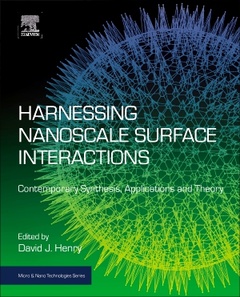Description
Harnessing Nanoscale Surface Interactions
Contemporary Synthesis, Applications and Theory
Micro and Nano Technologies Series
Language: English
Subjects for Harnessing Nanoscale Surface Interactions:
188 p. · 19x23.3 cm · Paperback
Description
/li>Contents
/li>Readership
/li>Comment
/li>
Harnessing Nanoscale Surface Interactions: Contemporary Synthesis, Applications and Theory provides coverage of contemporary theoretical and experimental approaches to understanding the interactions of molecules with nanomaterial surfaces and how to utilize these processes for improved synthesis and application of materials. The book reviews recently developed theoretical techniques to explore bonding interactions in nanoclusters and small molecules, along with modern molecular dynamics approaches for investigation adsorption of large molecules on nanomaterials. Novel experimental approaches are described that provide improved control of the synthesis of metal nanoparticles and measurement of their absorption properties.
The potential for nanomaterials to address a range of environmental problems is also demonstrated by a selection of specific applications. Chapters discuss experimental synthesis approaches, experimental analysis and applications, and theoretical approaches for harnessing nanoscale surface interactions.
CHAPTER 1 Sustainable utilization of renewable plant-based food wastes for the green synthesis of metal nanoparticles
CHAPTER 2 Nanotechnology and the environment
CHAPTER 3 Magnetic materials and magnetic nanocomposites for biomedical application
CHAPTER 4 Contemporary analysis of the influence of adsorbents on the structure, stability, and reactivity of main group nanoparticles using regional density functional theory
CHAPTER 5 A new DLVO-R theory: surface roughness and nanoparticle stability
CHAPTER 6 Nanomaterials in 3D bioprinting: synthesis, modification, and application
Materials Scientists and engineers, materials chemists, physicists, researchers working on nanomaterials
- Includes exploration of the latest theoretical techniques, including regional density functional theory and molecular dynamics simulations
- Addresses nanoscale interfaces and how they relate to the toxicity of nanomaterials, crucial for potential diagnosis and medical applications




